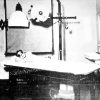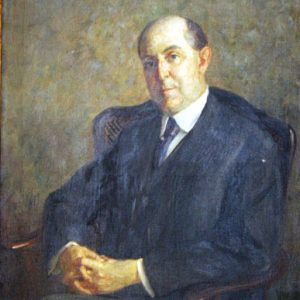calsfoundation@cals.org
Arkansas Territorial Centennial
In observance of the centennial anniversary of the creation of the Arkansas Territory, Governor Charles Hillman Brough endorsed a statewide commemoration planning effort in June 1919. The commemoration plans involved all seventy-five Arkansas counties, an extensive network of committees, hundreds of planners and fundraisers, and elaborate plans for the main centennial observance, scheduled to be held in Little Rock (Pulaski County) in November 1919. The observance failed to materialize, however, against a backdrop of concerns over a Spanish influenza recurrence and fundraising shortfalls.
The idea for a Territorial Centennial originated with Harvey C. Couch, president of Arkansas Power and Light Company (AP&L), who suggested a statewide celebration held in conjunction with the centennial of the Arkansas Gazette. In March 1919, the Arkansas Press Association passed a resolution calling for a statewide observation; in May 1919, Governor Brough announced formal plans for the celebration.
The planning effort consisted of a network of committees of prominent Arkansas business and civic leaders. Governor Brough headed the state committee, and Roy L. Thompson, president of the Little Rock Board of Commerce, acted as vice-chair. A group of 188 prominent men and women from around the state constituted an advisory board. Among them were the presidents of the state’s institutions of higher education, as well as representatives from all seven of the state’s congressional districts. Reporting to Brough was the Executive Committee, chaired by Little Rock banker Alfred G. Kahn, as well as committees on Publicity, Exhibits, and Finance. Newspaperman Clio Harper chaired the Publicity Committee, and Jim Ferguson, Commissioner of Mines, Manufactures, and Agriculture, chaired the Committee on Agricultural and Mineral Exhibits. C. C. Kavanaugh, prominent Democrat and chair of the Central Bank, headed the finance committee. Twenty-four subcommittees assisted the state-level committee in making arrangements for the Little Rock celebration.
Arkansas planners declared that this would be the “biggest celebration ever held in the state, and one of the biggest in the South,” perhaps setting unreasonably lofty expectations from the outset. Despite gubernatorial support for marking the milestone, the Arkansas General Assembly appropriated no funding for the celebration. The success of the event depended entirely on revenue raised by the finance committee, with subcommittees in all Arkansas counties. The estimated cost of the celebration was $75,000. The finance committee assigned fundraising quotas to each county, and in some cases sections of counties, and appointed eighty-four local chairmen and chairwomen to oversee the work. Pulaski County’s quota was $37,500, half the projected cost, with the remaining funds to come from the state’s other seventy-four counties in smaller increments. The state committee designated the third week in July as campaign week. During this week, the preparation for the celebration received intense publicity in state newspapers; meanwhile, county committees worked to secure funding. The committee’s goal was to receive all pledges by August 1.
In addition to fundraising, the local chairmen and chairwomen also coordinated planning activities in their counties. At the local level, the committee structure replicated the state-level structure, with committees on publicity and exhibits. The state committee encouraged each Arkansas county to send an exhibit to Little Rock in November, with each exhibit reflecting the theme of economic progress over the last century. In keeping with that theme, Crawford, Sebastian, and Boone counties planned to send displays on zinc mining, while Stone County’s display would focus on limestone extraction. Other counties focused on agricultural pursuits, with Sharp County planning to send a display on peach growing and Arkansas County an exhibit on cultivating and cooking rice. Other festivities planned for Little Rock during centennial week included a parade of fraternal organizations, a circus, and world championship heavyweight boxer Jack Dempsey’s vaudeville show.
Outside the planning committees, however, reaction to the centennial was lukewarm, with few counties actually meeting their quotas, even with the deadline for raising funds extended into August. By the end of August, only about ten counties had remitted their quotas in part or full.
The lack of support for the statewide centennial likely resulted from a combination of factors, including the rural and isolated conditions in which the majority of the state’s population lived; lack of good roads, which complicated the situation; and a general lack of wealth among Arkansas citizens. In early September 1919, the state committee announced the cancellation of the centennial due to a fear of the recurrence of the Spanish flu in the fall, although State Health Officer C. W. Garrison predicted minimal risk. The state began making plans for a smaller celebration in 1920; however, no such commemoration ever materialized.
For additional information:
Charles Hillman Brough Papers. Special Collections. University of Arkansas Libraries, Fayetteville, Arkansas. Finding aid online at https://uark.as.atlas-sys.com/repositories/2/resources/2410 (accessed October 28, 2022).
Lisenby, Foy. Charles Hillman Brough: A Biography. Fayetteville: University of Arkansas Press, 1996.
Scott, Kim Allen. “Plague on the Homefront: Arkansas and the Great Influenza Epidemic of 1918.” Arkansas Historical Quarterly 47 (Winter 1988): 311–344.
Speer, Lisa. “‘Arkansas’ [Not So] Big Birthday Party’: The Failed Centennial Celebration of 1919.” Arkansas Historical Quarterly 79 (Winter 2020): 348–365.
Lisa Speer
Ouachita Baptist University
 Early Twentieth Century, 1901 through 1940
Early Twentieth Century, 1901 through 1940 Recreation and Sports
Recreation and Sports Charles Brough
Charles Brough 



Comments
No comments on this entry yet.